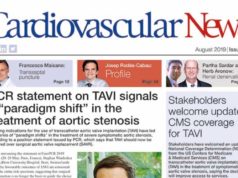
A consensus paper on the use of intracoronary imaging was released at EuroPCR 2019 (20–24 May, Paris, France) as a joint document with the European Association of Percutaneous Cardiovascular Interventions (EAPCI). It aims to provide the interventional community with guidance on when and how to use imaging technologies in clinical practice. Based on existing clinical evidence and contemporary best practice, the paper is the second on the use of imaging; the first paper was presented last year, and looked at the role of intracoronary imaging in guidance and optimisation of percutaneous coronary intervention (PCI) and its function in understanding mechanisms of stent failure.
On behalf of the EAPCI expert consensus group, Tom Johnson (Bristol Heart Institute, Bristol, UK) explained: “This second document is focusing on acute coronary syndrome [ACS], ambiguous coronary angiographic findings, and guiding interventional strategy in decision-making by imaging.”
He said: “The imaging consensus, both Part 1 and Part 2, acknowledges that there is increasing complexity of both our patients and lesions. Inherently, and particularly emphasised within this second document, we understand that invasive angiography is flawed in terms of its assessment, and we should be shifting towards a more precision-based medical strategy for our patients. Intracoronary imaging allows lesion characterisation … and it then will facilitate for us a tailored approach to intervention—from the pre-interventional strategy to subsequent stent deployment.”
The second Paper, which Johnson described as “slightly more troublesome to put together, as the data is more lacking in this environment”, consists of three themes: indications and the clinical value of intracoronary imaging in acute coronary syndrome, the role of imaging in vulnerable plaque detection & risk stratification, and the role of imaging in assessing lesion significance.
The Consensus Paper acknowledges that complex patients (for example, those with acute coronary syndrome or diabetes) and patients with complex lesions (such as chronic total occlusion [CTO], long lesions and left main stem) benefit from intravascular ultrasound (IVUS) guided PCI which has shown reduced major adverse clinical events, mainly driven by a reduction in target vessel revascularisation. An equivalence of IVUS and optical coherence tomography (OCT) has been confirmed in two rigorously designed randomised controlled trials, OPINION and ILUMIEN III. However, as outlined in part 1, studies utilising imaging-based optimisation criteria have demonstrated failure to achieve optimal criteria in up to half of all patients. This part reflects the challenges of defining the criteria and the increasing complexity of coronary disease. Dr Johnson reinforced that improved outcomes require the interventionist to understand the underlying lesion substrate, before stenting, and then to guide lesion preparation and stent selection with intracoronary imaging.
The first consensus outlined the role of intracoronary imaging in the characterisation of calcification, where a calcific arc >180° with thickness >0.5mm and longitudinal length >5mm is predictive of stent under expansion. Beyond this, there is an expanding role for intracoronary imaging to assess and guide modification strategies for high-burden calcification.
In cases where angiographic assessment is challenging—aneurysmal disease or aorto-ostial lesions—the Consensus Paper suggests that difficulties can be overcome with the use of intracoronary imaging. And where angiographic assessment is uncertain, it can be used to delineate the aetiology of acute coronary syndrome, which can impact future treatment if atherosclerotic disease can be ruled out. The document also states that intracoronary imaging for lesion and patient stratification can guide intensification of treatment and minimise future events, and its use should be mandatory in cases of lesion failure to guide repeat intervention.
Johnson summed up: “We really see imaging as central to the role of understanding the aetiology of acute coronary events, particularly in the non-obstructive or near normal coronary angiogram. Beyond that, in terms of vulnerable plaque detection & risk stratification, there appears to be evidence that a multi-modality approach to understanding the underlying plaque type is probably relevant in terms of intracoronary imaging. In terms of lesion significance … we have strengthened guidance on revascularisation of left main stem disease to recommend that an MLA [minimal lumen area] of <4.5mm2 should actually push the interventionist to revascularise, either by percutaneous or surgical means. And if the MLA is exceeding 6mm2 then a conservative strategy is mandated. But between 4.5 and 6mm2 then a physiological assessment should be undertaken.”
The paper has been endorsed by three societies—the Cardiac Society of Australia and New Zealand, the Chinese Society of Cardiology, and HK Stent Hong Kong Society. The consensus group was made up of 22 co-authors, the vast majority of whom were European, with American, Japanese, and Chinese co-authors also included.











